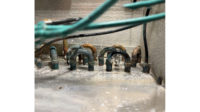What is the difference between pipes and tubing? Many technicians commonly interchange the use of these terms; however, there is a technical difference between the two, and that is how they are sized.
Pipes are sized based on their nominal pipe size (NPS), which is the approximate, but not exact, inside diameter. The inside diameter will vary based on the pipe’s wall thickness, which is known as its schedule. The outside diameter is held constant. The schedule of a pipe can vary based on how it is ordered. For example, the inside diameter of a 2-inch schedule 40 pipe is 2.067 inches, whereas the inside diameter of a 2-inch schedule 80 pipe is 1.939 inches. The outside diameter for both is 2.375 inches, and their inside diameters are close to 2 inches.
Tubing is sized based on its outside diameter. The wall thickness of tubing can also vary, and its inside diameter will vary based on its wall thickness. For example, the outside diameter of a ½-inch type L copper tubing is ½-inch, with a nominal wall thickness of 0.035 inches. The outside diameter of a ½-inch type M copper tubing is also ½ inch, however with a nominal wall thickness of 0.025 inches.
Type L air conditioning and refrigeration (ACR) tubing is commonly used on refrigeration system piping. The inside surface of ACR tubing is specifically manufactured to be cleaned, dehydrated, and the tubing capped to avoid contamination prior to its installation. This is vastly different from copper pipe used in plumbing work, which usually has oils and grease or other contaminants on its interior wall — which can cause serious issues if used on refrigeration systems.
Stored ACR tubing should always be capped and protected against contaminants entering the tubing. It is also extremely important to leave the tubing capped during the installation process, just up to the point of being connected to a system component or coupled to another section of tubing. It is very easy for containments to accidentally enter the tubing while running it across a ceiling or through a wall or simply moving from one area to another.
The original end caps that come with the tubing adequately protect the tube end and should be left on during the installation process and then moved to the unused tubing. It is a good practice to save any old end caps and have extras for future use, as they come in very handy. In lieu of the original end caps, electrical tape can also be used to seal the ends. I prefer to wrap the ends with the glued end facing up so that the glue from the tape does not get on the tubing. This makes it easier to connect the tubing later. The glue can be removed, or a bit of the ends cut off; but if the glue was not there, it’s one less step to deal with while connecting the tubing.
The bottom line is to always protect your refrigerant tubing. It is much easier to prevent containments from entering a system then to deal with removing them or the system failure they will cause.









